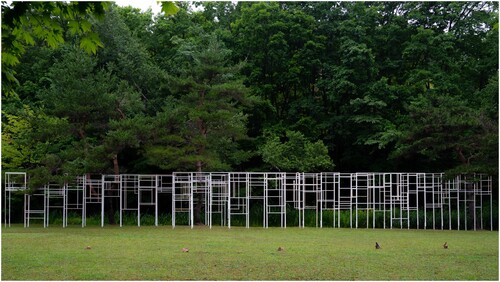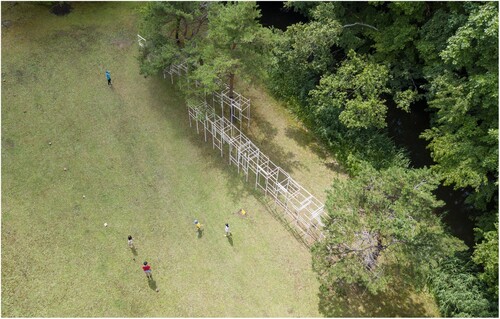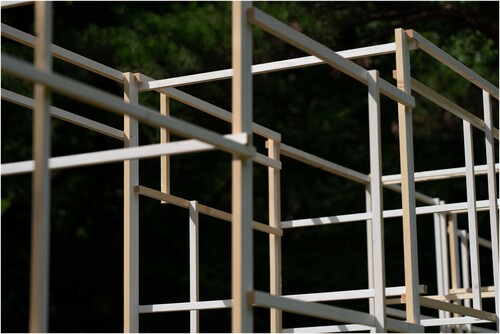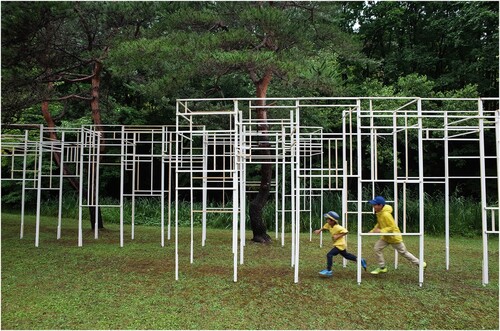Abstract
This intervention describes the installation art piece, named 107 m3 Pavilion, inspired to reveal the 'difference' between the breath a human's CO2 emission versus a tree's absorption. The disparity in the extent of breath creates imbalance.
This installation art piece was exhibited at the Benizakura Park Art Annual 2018, a private park in Sapporo, Hokkaido, Japan. I named it ‘107 m3 Pavilion’ to indicate the ‘difference’ between the breath each individual human takes versus the breath of a tree. With the work, I was especially interested in conveying that the disparity of breath creates imbalance (see also Yamada Citation2023).
The place where 107 m3 Pavilion () is situated was once a heavily wooded area in the west part of Hokkaido, which is the northernmost major island in the Japanese Archipelago (Benizakura Park Citation2023). The Ainu natives, known for their hunting culture, paid their sincere respects to the wooded area for its rich habitation of animals. The abundant deep forests succumbed to tree logging due to the increasing population of Sapporo city about a hundred years ago. Numerous trees were harvested to supply lumber for building houses in the area.
A human’s carbon dioxide emission per year is about 112 m3Footnote1 while a tree absorbs only 5 m3Footnote2 in photosynthesis per year. In this work, this huge ‘difference’ between a human’s CO2 emission and a tree’s absorption becomes the main concept. I visualized the ‘difference’ as 112 minus 5=107 m3 in 107 m3 Pavilion, the size of which is about 35.7 m long, 2.7 m high and 1.1 m wide. The pavilion () is made of over 500 pieces of around 2 cm X 2 cm lumber. This was the smallest sustainable size of lumber to construct this installation with the utmost effort to minimize the amount of wood harvested (). All the both sides white small lumber pieces contrast against the deep and dark green grandeur background to reflect the forest’s importance and impressiveness (see video and images at https://www.ryoyamada.com/107m3-pavilion). 107 m3 Pavilion itself also echoes the unique pattern of curves and contrasts that Japanese pine trees feature ().
Figure 1. Photograph of 107 m3 Pavilion, with its white timbers emerging from a background of deep dark green. Wood construction, Benizakura Park, Sapporo. Photograph courtesy of author.

Figure 2. Photograph of 107 m3 Pavilion. Wood construction, approx. total length 35.7 m. Benizakura Park, Sapporo. Photograph courtesy of author.

Figure 3. Photograph of 107 m3 Pavilion, made of over 500 pieces of around 2 cm X 2 cm, both sides white painted lumber. Photograph courtesy of author.

Figure 4. Photograph of 107 m3 Pavilion; its unique geometric pattern generates contrasts with the curves of Japanese pine trees. Wood construction, Benizakura Park, Sapporo. Photograph courtesy of author.

Through this pavilion, I hope to help visitors realize the importance of how much we, the people of today, need trees and woods for modern living, and how much the natives of this area, the Ainu, paid respect to the place as the source of their livelihood. 107 m3 Pavilion is a special entity that reflects the preciousness of the woods by contemplating the difference between a breath taken by a human and a breath taken by a tree (https://www.ryoyamada.com/107m3-pavilion).
Disclosure statement
No potential conflict of interest was reported by the author(s).
Additional information
Notes on contributors
Ryo Yamada
Ryo Yamada is a Japanese artist and architect, and maintains a professorship at Edinburgh Napier University, Scotland (since 2023). He was born in Tokyo in 1968 and granted a PhD in art from the Tokyo University of the Arts. His projects are situated beyond boundaries of architecture and art, and emphasize the connection with nature and the environment through spatial investigations mostly integrating wood and textiles as central elements. Yamada stresses the language of the material, a theme also prominent in his teaching at various universities, including Sapporo City University School of Design (Japan), where he has taught since 2007. He has been awarded many international design awards, and has also published academic journal articles. His activities are uniquely as environmental artist and researcher, drawing upon and developing successful work in design and academic institutions.
Notes
1 The amount of human's breathing per day is estimated to be 19 m3 (National Institute for Environmental Studies, https://www.cger.nies.go.jp/ja/library/qa/26/26-1/qa_26-1-j.html). In this article, for comparison with trees, the human emission is calculated based on around 8 hours of light-work and rest.
2 The annual CO2 absorption amount of one-hectare of cedar plantation is estimated to be approximately 8.8 tons. Based on this data, a 40-year-old cedar tree's annual CO2 absorption amount can be estimated to be 4.9 m3 (Ministry of Agriculture, Forestry and Fisheries, https://www.rinya.maff.go.jp/j/sin_riyou/ondanka/20141113_topics2_2.html).
References
- Benizakura Park 2023. https://www.benizakura.jp/information/. Accessed 4 October 2023.
- Yamada, Ryo. 2023. https://www.ryoyamada.com/. Accessed 4 October 2023.
- Summary in Japanese:
- 和文
- 107㎥のパビリオン
- この作品は、わたしたちひとり一人の呼吸と、樹木一本の呼吸のアンバランスの「差」を表現しています。
- 作品(インスタレーション アート)が設置されたこの敷地はかつて深い森でした。日本の最北である北海道の西に位置します。先住民のアイヌ民族は、この地を狩猟の森として敬意を持っていました。約100年前に、この地は樹木を伐採するための森になりました。人口が増えたこの地へ住宅を建設する大量の木材を配給するためです。
- 作品は、樹木と人間の「呼吸」をテーマにしています。人の呼吸による年間の二酸化炭素排出量は約112㎥に対し、一本の樹木は約5㎥を吸収しているにすぎません。この二酸化炭素の排出と吸収の「差」を作品のコンセプトにしました。「112ー5=107㎥」。この体積を約35m長さ・2.7m高さ・1.1m幅のパビリオンで可視化しています。
- この作品により、わたしたちがいかに樹木を必要としているか、そして先住民の住んだこの地の尊さを知ることができます。素材は2cm x 2cmの最も細い製材約500本で構築し、伐採された樹木から最大の本数を生み出しています。背後の深く濃い緑にはえるよう白色塗装とし、日本の松の曲線とコントラストを生む形状パターンになっています。
- この作品は、わたしたちひとり一人の呼吸と、樹木一本の呼吸のアンバランスの「差」を表現することで「森の尊さ」を表現する優しい存在です。

